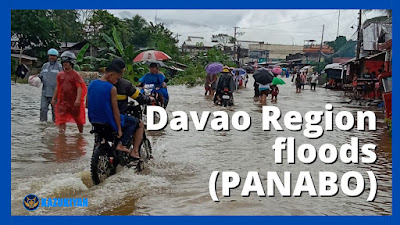Davao Region floods especially Panabo City experience heavy rain
Davao Region, particularly Panabo City, has been inundated with heavy rainfall, resulting in flooding across the area. As of the time of writing this article, the flood situation has begun to normalize (Though still rain is pouring), with the rain subsiding compared to previous days. However, several cities, including Panabo City, Davao City, and Tagum City, have been significantly affected.
Fortunately, both individuals and government agencies have been actively engaged in assisting affected families by providing support in evacuation centers. Despite the challenges posed by the strong flood currents, efforts are being made to ensure the safety of all citizens, with some travelers unable to pass through certain areas due to the intensity of the flooding. Additionally, the GCASH app temporarily disappeared from the Play Store due to updates and maintenance. However, it is important to note that transactions and funds remain secure, as confirmed by the Official GCASH Facebook page.
Returning to the primary focus, many individuals are facing personal challenges such as obtaining food and completing laundry tasks amidst the flood crisis. In response to the situation, the government has announced the suspension of classes and government work to prioritize the safety and well-being of citizens. This decision aims to alleviate the burden on affected individuals and facilitate ongoing relief efforts.
Due to the situation, the DFA has also canceled all appointments for individuals scheduled from February 1 and 2 (though the specific dates may vary, as reported by some of my friends). These appointments have been rescheduled to February 17 or later.
The article highlights the impact of heavy rainfall and flooding in Davao Region, particularly in Panabo City. It's concerning to see the disruption and challenges faced by residents due to the adverse weather conditions. Here are some reactions and ways to implement safety precautions based on the article:
- Immediate Action: The first reaction should be to ensure the safety of individuals affected by the flooding. Evacuation centers should be properly equipped and accessible to provide shelter, food, and medical assistance to those in need, ensure that you also check social media updates from the official page and watch the news.
- Community Support: It's commendable to see both individuals and government agencies actively involved in assisting affected families. Community support initiatives, such as donation drives for essential supplies and volunteer efforts to aid in relief operations, can further strengthen these efforts, you can also share your own tools, food, or something that could help the community.
- Road Safety: Given the risks posed by strong flood currents, it's essential to prioritize road safety. Authorities should provide clear signage, barricades, and alternative routes to prevent accidents and ensure the safety of travelers. I suggest canceling your travel while the situation still present to avoid any unexpected events.
- Technology Updates: The temporary removal of the GCASH app from the Play Store highlights the importance of staying informed about technological updates and maintenance schedules. Users should regularly check official communication channels for updates and ensure the security of their financial transactions, make sure you only get the latest updates from the official page or social media accounts of the platform.
- Preparedness Measures: Residents in flood-prone areas should proactively implement preparedness measures to mitigate the impact of flooding. This includes raising awareness about evacuation procedures, securing valuables, and having emergency kits stocked with essential supplies.
- Education and Awareness: Educating the community about the risks and safety precautions during flooding is crucial. Local authorities can conduct awareness campaigns, distribute informational materials, and organize training sessions on disaster preparedness and response.
- Infrastructure Improvement: Long-term solutions, such as infrastructure improvements and flood control measures, are necessary to address the root causes of flooding and enhance resilience against future disasters. This may include the construction of drainage systems, river embankments, and flood barriers.
By implementing these safety precautions and fostering community resilience, the impact of heavy rainfall and flooding can be minimized, and the safety and well-being of residents can be ensured.


Post a Comment